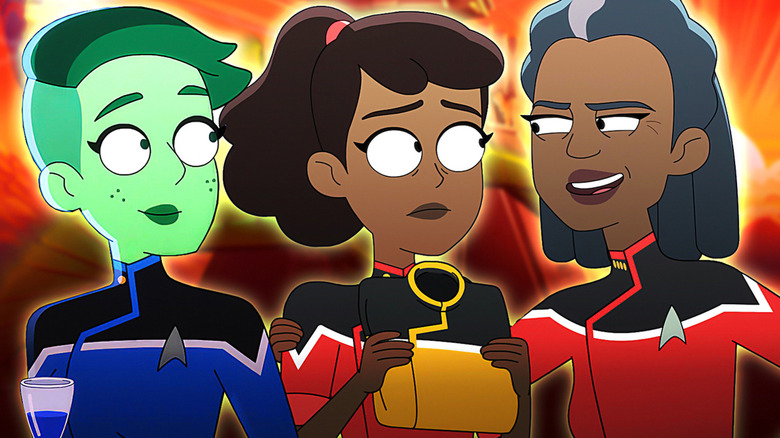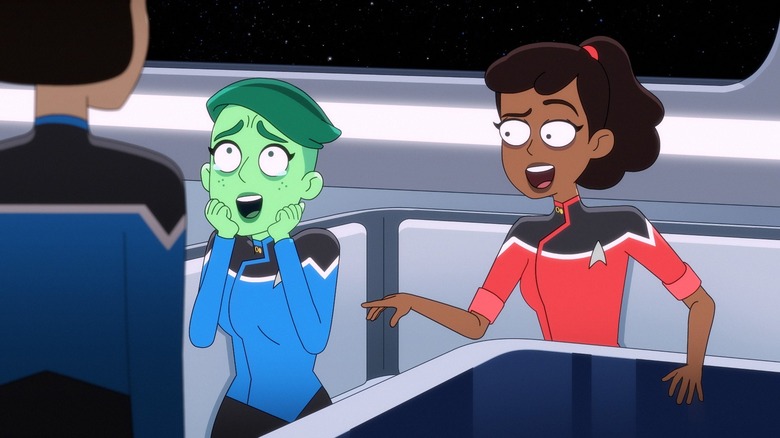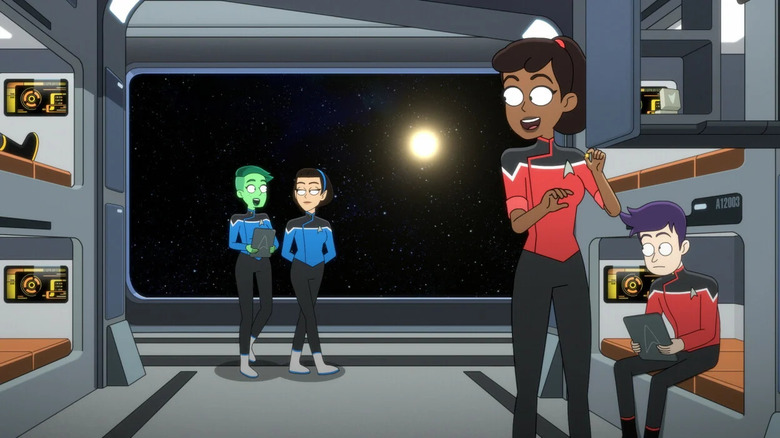More Goes Into Choosing A Star Trek: Lower Decks Uniform Color Than You'd Think [Exclusive]
Heading into its fifth and final season, the Emmy-nominated "Star Trek: Lower Decks" will go down as one of the all-time great "Star Trek" series. The hit animated series on Paramount+ centers on the support crew of the U.S.S. Cerritos in the year 2380, one of Starfleet's least important ships. Ensigns Mariner, Boimler, Rutherford, and Tendi take audiences on adventures big and small all across the galaxy, but "Lower Decks" is ultimately a show about friendship and growing up. A fantastic "Star Trek" show made by people with a clear love of the existing universe, it also boasts some of the best animation currently on TV, courtesy of Titmouse Inc.
I was recently invited to Titmouse Inc. studios where I was able to speak with Barry Kelly — who serves as supervising director on "Star Trek: Lower Decks" and has also directed several episodes. Considering how memorable the "Star Trek" iconography of costuming, set pieces, and character designs have become, I had to know ... how do they translate those trademark shirt colors from live-action to animation? Admittedly, I was terrified asking Kelly this question would be an insult to the craft, but as it turns out, there's a lot of planning that goes into choosing the perfect shade of Redshirt.
"I think Mike [McMahan, the show's creator] really just wanted to do the primary colors," he tells me. "It was trying to find a nice one that doesn't clash too much with a bright green character's skin color because sometimes we color correct and her skin color can easily get blended with the blue." Kelly was referring to D'Vana Tendi (voiced by Noël Wells), an Orion with mint-green skin. "It's also ... honestly, it's usually trying to find how many variations of skin colors worked okay with it."
Color selection is all about contrast
In the same sense that lighting in live-action can dramatically change the look of a character's skin or costuming, color-correcting in animation is a massive factor in selecting what shade to use. "Boimler [voiced by Jack Quaid] is so pale, and when we go to color correct, he just starts glowing," Kelly says. "So we have to tone that down. It's all about contrast." The four main Ensigns "Lower Decks" spends most of its time with all have different skin tones, with Bradward "Brad" Boimler representing the lightest and Beckett Mariner (voiced by Tawny Newsome) the darkest. The duo also both wear red Starfleet uniforms, meaning the red shade of costume must match each character and work well with the differing skin tones.
There is a base shirt color for each of the characters on their model sheets, but after color correction takes place, they have to integrate the correct color shot by shot. "The background's going to determine even more than the skin color most of the time, just so that we make sure that you can see them," Kelly explains. "So if you were to color-pick every shot of the universe, it's probably never the same, it's probably slightly different by the end, depending on the scene they're in." The shades of red on the ship against gray walls will most certainly look different compared to when they're standing in front of the darkness of space shown through the viewport.
Star Trek: Lower Decks is crafted with love
Barry Kelly also notes that it's "crazy," but that "Star Trek: Lower Decks" is animated using the same process as cartoons he made 20 years ago, just with different programs. "I still say Flash, but its Adobe Animate, but it's still the same process where it's the characters are animated in Flash, then backgrounds are in Photoshop, After Effects is all compositing, and then we're still in all Adobe Suite almost the whole time." He jokes that he keeps telling himself he needs to learn all the new software and the most advanced technology, but as Titmouse Inc. co-founder and CEO Chris Prynoski added during our chat, "The most advanced technology is talented artists." And "Star Trek: Lower Decks" is made by some of the very best in the industry.
The post-production for season 1 of the series was done remotely due to the quarantine era of the pandemic, but now, "Lower Decks" is a family. "It's really funny, we've all been animating on shows for a long time and shows are funny, but you can tell in the room when animators are watching their own shots or [...] not everyone's laughing," Kelly says. "And then in this show, everybody laughs. It's a genuinely funny show."
Unsurprisingly, there are plenty of Trekkies on staff, which makes reading the scripts for the first time one of the best parts of the job. "We laugh really hard at the scripts and we're like, 'Crap, now we've got to make this show, we got to make it as funny as it was when we read it.'" Fortunately, they've consistently pulled it off; "Lower Decks" is consistently heartfelt and straight-up hilarious, even after four seasons. Alas, Kelly wouldn't give me any spoilers for season 5, but he assures me, "It's going to be an awesome last season."
"Star Trek: Lower Decks" season 5 is due out in fall 2024.


